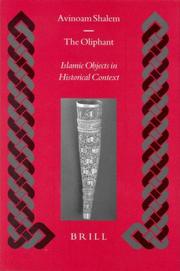| Listing 1 - 3 of 3 |
Sort by
|
Book
ISBN: 8021082356 9788021082359 9788021074132 Year: 2014 Publisher: Brno, [Czech Republic] : Masarykova univerzita,
Abstract | Keywords | Export | Availability | Bookmark
 Loading...
Loading...Choose an application
- Reference Manager
- EndNote
- RefWorks (Direct export to RefWorks)
Christian art and symbolism --- Diptychs. --- Ivories, Early Christian --- Early Christian ivories --- Tablets (Paleography)
Book
ISBN: 0691640149 0691612218 1400857422 9781400857425 0691035741 9780691612218 9780691035741 Year: 2014 Publisher: Princeton, NJ
Abstract | Keywords | Export | Availability | Bookmark
 Loading...
Loading...Choose an application
- Reference Manager
- EndNote
- RefWorks (Direct export to RefWorks)
Kurt Weitzmann demonstrates that the postulated miniatures of the handbook that goes under the name of Apollodorus migrated into other texts, of which the commentary of Pseudo-Nonnus--attached to several homilies of Gregory of Nazianzus--and the Cynegetka of Pseudo-Oppian are the most important.Originally published in 1984.The Princeton Legacy Library uses the latest print-on-demand technology to again make available previously out-of-print books from the distinguished backlist of Princeton University Press. These editions preserve the original texts of these important books while presenting them in durable paperback and hardcover editions. The goal of the Princeton Legacy Library is to vastly increase access to the rich scholarly heritage found in the thousands of books published by Princeton University Press since its founding in 1905.
Mythology, Greek, in art. --- Ivories, Byzantine. --- Illumination of books and manuscripts, Byzantine. --- Byzantine ivories --- Byzantine illumination of books and manuscripts --- Illumination of books and manuscripts, Byzantine --- Ivories, Byzantine --- Mythology, Greek, in art --- 091.31 --- 091 =75 --- 091.31 Verluchte handschriften --- Verluchte handschriften --- 091 =75 Handschriftenkunde. Handschriftencatalogi--Grieks --- Handschriftenkunde. Handschriftencatalogi--Grieks --- Illumination of book and manuscripts, Byzantine

ISBN: 9004137947 9786610914975 9047405102 1280914971 1429427493 9781429427494 9789004137943 Year: 2004 Publisher: Leiden Boston
Abstract | Keywords | Export | Availability | Bookmark
 Loading...
Loading...Choose an application
- Reference Manager
- EndNote
- RefWorks (Direct export to RefWorks)
Setting a group of medieval carved ivory horns in the specific artistic and historical context in which they were manufactured, used and re-used, this book presents a mine of information for the study of medieval history. The first chapters explore such technical aspects as the cutting and carving of oliphants, and also the broader issues of the morphology of ivory and its availability in the Mediterranean basin in the Middle Ages. On the basis of specific carving methods and varying vocabulary of motifs, the oliphants are organized into groups and their probable sites of production are suggested. The core of this volume, however, is the attempt to place them in their specific historical context. The purpose of their mass-production, namely their patronage and original function, is explored, but also their reception and new functions in the church treasuries of Latin Europe is broadly discussed
Decorative arts, Fatimid --- Oliphant --- Olifant --- Oliphants --- Ivories --- Wind instruments --- Fatimid decorative arts --- Influence --- Oliphant. --- Influence. --- Art islamique --- Cor --- Décoration islamique --- Civilisation islamique --- Ivoires --- Moyen âge
| Listing 1 - 3 of 3 |
Sort by
|

 Search
Search Feedback
Feedback About UniCat
About UniCat  Help
Help News
News